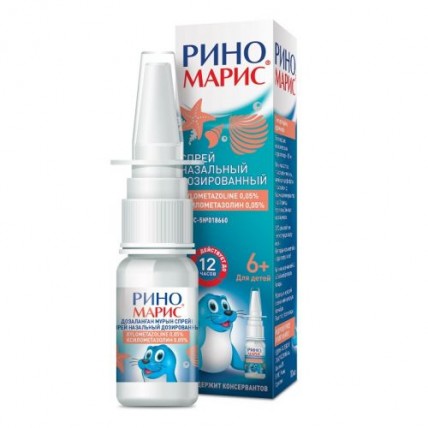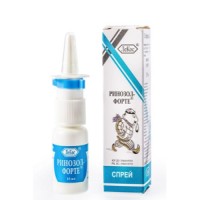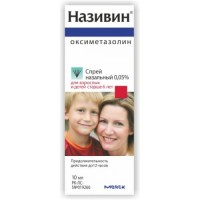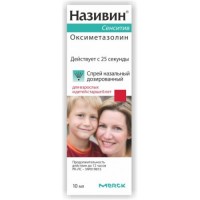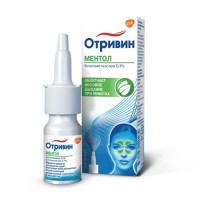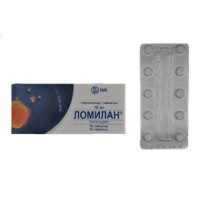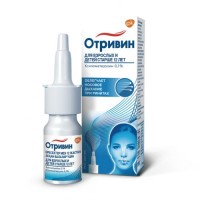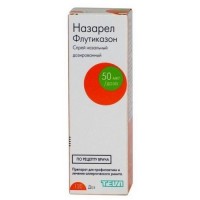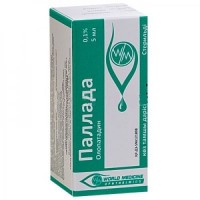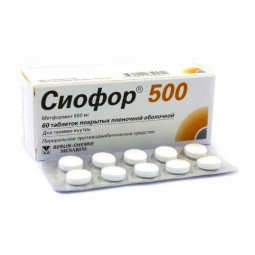Rinomaris 0.05% 10 ml nasal spray metered
- $6.60
The instruction for medical use of Rinomaris® medicine the Trade name of Rinomaris® the International unlicensed name Xylomethazolinum Dosage Form Spray the nasal Structure of 1 ml of solution dosed 0.05% and 0.1%, 10 ml contains active agent – xylomethazolinum a hydrochloride of 0.5 mg or 1.0 mg, excipients: the water sea purified potassium dihydrophosphate, water purified. Description Transparent colourless solution. Pharmacotherapeutic group Nasal drugs. Antikongestanta and other nasal drugs for topical administration. Sympathomimetics. Xylomethazolinum. The ATX R01AA07 code the Pharmacological Pharmacokinetics At properties topical administration of Rinomaris® is practically not absorbed in this connection, data on pharmacokinetics of drug are not provided. The pharmacodynamics Xylomethazolinum is derivative imidazoline, possesses alpha adrenomimeticheskim action. At topical administration causes narrowing of blood vessels of a mucous membrane of a nose, eliminating, thus, hypostasis and hyperaemia of a mucous membrane of a nasopharynx. Facilitates nasal breath in rhinitises. In therapeutic concentration does not irritate mucous, does not cause hyperaemia. Action comes in a few minutes after use and continues within 12 hours. The sterile sea water which is a part of drug promotes maintenance of the normal physiological state of a mucous membrane of a nasal cavity, fluidifying of slime and normalization of its development in scyphoid cells mucous a nose. Microelements improve function of a ciliary epithelium that allows to lower local side reactions in the form of irritation and/or dryness of a mucous membrane of a nasopharynx. Indications - for relief of symptoms of congestion of a nose, connected with cold - year-round allergic rhinitis - sinusitis the Route of administration and doses of 0.05% spray - to children are from 6 to 12 years: on 1-2 injections in each nasal course 1-2 times a day. 0.1 the % spray - to children is more senior than 12 years and the adult: on 1 injection in each nasal course 2-3 times a day. It is not necessary to use drug more than 3 times a day. Duration of a course of treatment is defined by the doctor. Side effects Determination of frequency of by-effects is carried out according to the following criteria: very often (≥ 1/10), it is frequent (≥ 1/100, & lt, 1/10), infrequently (≥ 1/1000, & lt, 1/100), is rare (≥ 1/10000, & lt, 1/1000), is very rare (& lt, 1/10000), frequency is not known. Often: - burning sensation in a nasal cavity and a throat, local irritation, sneezing, xeromycteria - irritability, concern, an ischuria, a headache - medicamentous rhinitis, especially at prolonged and/or frequent use - decrease in effect at long and/or frequent use - from a cardiovascular system, especially at prolonged and/or frequent use - from the central nervous system, especially at prolonged and/or frequent use Infrequently: - system allergic reactions (Quincke's edema, rash, an itching) - hypostasis of a mucous nasopharynx after the treatment termination, nasal bleeding Is rare: - heartbeat, tachycardia - hypertensia - nausea Very seldom: - hyperexcitability, insomnia, a drowsiness/somnolence (is more often at children) - hallucinations (more often at children), a headache, dizziness, spasms (is more often at children) - arrhythmia - an apnoea at children and newborns patients Should appoint with care with cardiovascular diseases. In some cases system allergic reactions and short-term disorders of vision can be observed. Contraindications - hypersensitivity to xylomethazolinum or any other component of drug - simultaneous use of other sympathomimetic decongestants - cardiovascular diseases, including arterial hypertension - tachycardia - the profound atherosclerosis - glaucoma - a pheochromocytoma - diabetes - atrophic rhinitis - a hyperthyroidism - simultaneous use with monoamine oxidase inhibitors (MAO or within 14 days after the treatment termination) - simultaneous use with beta-blockers - inflammation of skin and/or mucous membrane of a vestibule of the nose - after transsphenoidal hypophysectomy or other transnasal or transoral surgical interventions on a firm cover of a brain - children's age up to 6 years (for 0.05% of solution) - the children's age up to 12 years (for 0.1% of solution) Medicinal interactions Is incompatible with inhibitors of a monoaminooxidase (MAO), tricyclic or tetracyclic antidepressants. Patients should appoint the special instructions Rinomaris® with care: - at which at use of sympathomimetic means, the strong reactions which are expressed as insomnia, dizziness, a tremor, disturbance of a warm rhythm or increase in arterial blood pressure - taking tricyclic antidepressants or other drugs which can increase arterial blood pressure - accepting α-blockers - with the increased intraocular pressure are noted, especially, with closed-angle glaucoma - with a prostatauxe - with a porphyria Drug should not be used for a long time, for example, in chronic rhinitis. Long-term treatment by drug can cause converse effect. At use of drug for patients with hypersensitivity of a mucous membrane of a nose, there can be a feeling of discomfort. Precautionary measures: - it is not necessary to exceed the specified dose - it is not necessary to use continuously within more than seven days in a row. If symptoms of a disease do not pass, it is necessary to see a doctor. - before use of drug at pregnancy and a concomitant use of other medicines, it is necessary to consult with the doctor - each bottle has to be used only by one patient for prevention of cross infection - it is not necessary to use after recently performed neurosurgical operation Pregnancy and the lactation period Data on use of Rinomarisa® during pregnancy are absent. There are no data on penetration of xylomethazolinum into breast milk. As there is a probability of emergence of system side effects (generally vasoconstrictive effect), use of drug during pregnancy and in the period of a lactation perhaps only after careful assessment of a ratio of possible advantage for mother and risk for a fruit (child). Features of influence on ability to run motor transport or other mechanisms. In the dosages exceeding recommended can influence ability to run transport or potentially dangerous mechanisms. Overdose Symptoms: strengthening of side effects. In rare instances of poisoning at children, the clinical picture was noted generally by such signs as acceleration and irregularity of pulse, increase in arterial blood pressure and also consciousness turbidity. Treatment: there is no specific treatment, symptomatic therapy is carried out. A form of release and packing On 10 ml of drug in the plastic bottle supplied with the raspylitelny device and a protective cover from propylene. On 1 bottle together with the instruction for use in the state and Russian languages put in a pack from cardboard. To Store storage conditions at a temperature not above 25 °C. To store out of children's reach! 2 years to Use a period of storage within 3 months after opening of a bottle. Not to apply after an expiration date. Prescription status Without prescription YaDRAN-GALENSKI Producer of LABORATORIES and. lake, Svilno 20, 51000 Rijeka, Croatia Name and country of the owner of the registration certificate of YaDRAN-GALENSKI of LABORATORIES and. lake., Croatia Name and country of the YaDRAN-GALENSKI organization packer of LABORATORIES and. the lake, Croatia the Name, the address and a contact information of the organization in the territory of the Republic of Kazakhstan, the accepting claim (offer) on quality of medicine from consumers and responsible for post-registration observation of safety of medicine Representation of YaDRAN-GALENSKI of LABORATORIES and. lake. Republic of Kazakhstan, 050059, Almaty, Zhamakayev St., 126
